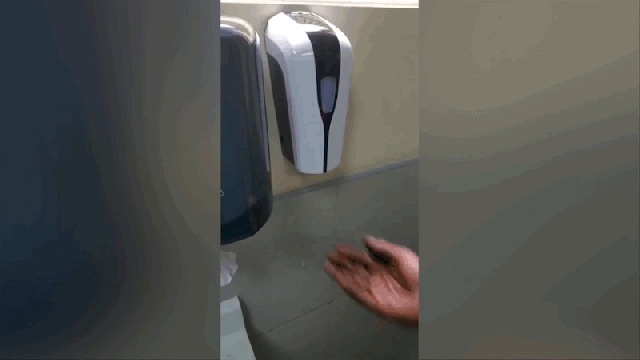GIF: Facebook/Chukwuemeka Afigbo
On Wednesday, a Facebook employee in Nigeria shared footage of a minor inconvenience that he says speaks to tech’s larger diversity problem. In the video, a white man and a dark-skinned black man both try to get soap from a soap dispenser. The soap dispenses for the white man, but not the darker skinned man. After a bit of laughter, a person can be overheard chucking, “too black!”
If you have ever had a problem grasping the importance of diversity in tech and its impact on society, watch this video pic.twitter.com/ZJ1Je1C4NW
— Chukwuemeka Afigbo (@nke_ise) August 16, 2017
Most likely, the soap dispenser uses an optic sensor to detect when a hand is placed underneath. While more advanced sensors don’t have a problem with dark skin, cheaper ones (like in a bathroom soap dispenser) can have issues. When reviewing wearables, CNET spoke to Bharat Vasan, the COO of Basis Science, who explained how these monitors fail people of colour:
“The light has to penetrate through several layers…and so the higher the person is on the Fitzpatrick scale (a measure of skin tone), the more difficult it is for light to bounce back,” he explained. “For someone who is very pale in a very brightly-lit setting, the light could get washed out. The skin colour issue is something that our technology compensates for. The darker the skin, the brighter the light shines, the lighter [the skin] the less it shines.”
While soap dispensers are a more light-hearted example, this same problem has been documented in wearable fitness trackers and heart-rate monitors, with much more dire consequences. Health inequities for people of colour are well documented. And while no wearables maker would suggest they’re a substitute for professional healthcare, it’s still troubling that the people most at risk for a condition like heart disease will have more difficulties conveniently accessing or monitoring the condition on the go.

A user of Xiao Mi’s Mi Band 2 Heart Rate monitor says the device can’t detect his heart rate on his wrist, but can on his fingertip. (Image: Miui.com)
In his original post, Afigbo hypothesized that “having a dark skinned person on the team would have resulted in a better product.” And surely, testing the product on a variety of skin tones would have at least alerted them to the problem. Skin tone recognition is a clear problem in tech that, given the industry’s indefensible homogeneity, is sadly ignored.
